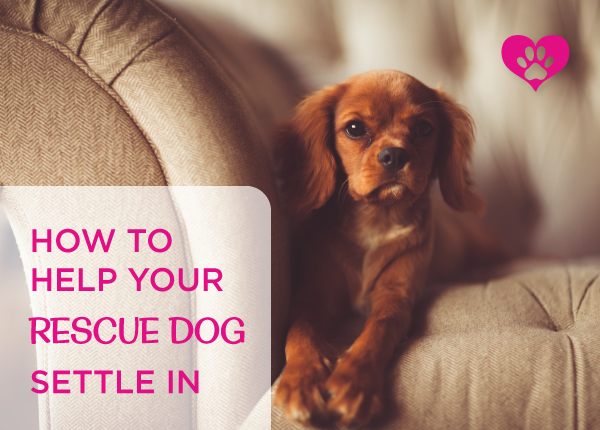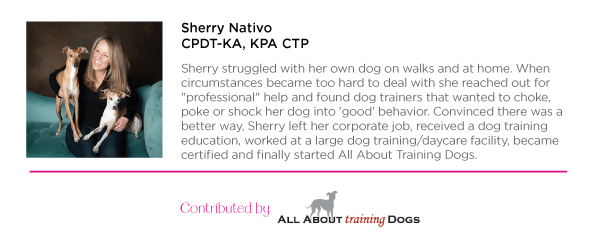
Home introduction
Step 1
When you arrive home, take your dog out for a walk or let him explore your enclosed backyard. Walks in the neighborhood should only be done when the dog has been fitted with a secure harness. Since this is his first time in his new neighborhood go slow and let him sniff. If your new dog is nervous and is pulling on the leash, then take him inside or let him explore the backyard. Once he has eliminated you can take him inside.
Step 2
Introduce him to his new home on leash, including the confinement area. A confined area could be an area blocked off with a baby gate, an exercise pen area, or a crate.
Step 3
Take off his leash, give him a chew or a stuffed Kong.
Start alone-time training now. Begin getting your dog used to short absences within the first few hours of his arrival. You will want to spend every minute with your dog when he first comes home, but it is better to prepare him for a normal routine right away. He must learn to be relaxed, calm, and settled when alone—and this doesn’t come naturally to dogs, social animals that they are.
House-training 101
Dogs that are potty trained in their foster home will have to re-learn this in their new home. Potty accidents can happen even with adult, previously house-trained dogs. It is not at all obvious to dogs that the bathroom rules in one place apply everywhere else. Take your new family member outside to eliminate every 2 – 3 hours and then reward him with treats. Prevent accidents by watching your dog when inside and use a baby gate to block rooms and areas where you can’t see him. Crates and ex-pens can be used when you can’t watch your dog. With a little patience and supervision, your dog will soon be fully versed in potty etiquette.
- Until your dog is perfectly house-trained, don’t leave him alone except in his confinement area (gated kitchen, exercise pen area or crate).
- If you see your dog sniffing and circling in the house, take him out immediately.
- Praise and reward your dog with a treat when he relieves himself outdoors.
- Never yell or punish your dog for a potty accident, otherwise he may become afraid to relieve himself in front of you.
Pairing your house with good experiences
Dogs learn by association or by pairing safe as good and bad as dangerous. Many behavior issues (barking, growling, biting, etc) stem from a negative association, which translates into danger for the dog. From the beginning make sure you set some positive association for your new dog. That means a lot stuffed Kongs and toys, limited family visits and trips to the outdoor mall. Hold the hugs—for now. Allow time for you and your dog to get to know each other before you try to handle him completely. Dogs can be just as particular as humans about being touched by strangers and as long as your relationship is brand new, proceed with respect. You wouldn’t ask for more than a kiss on a first date, right? To make it a pleasant experience for your dog to be touched, offer a treat every time you touch him in a new area. Any kind of grooming or holding should be minimal at first and always combined with lots of delectable treats. If your dog is on medication of some kind, be extra gentle and careful. A good rule of thumb is to let the dog initiate petting sessions until you know each other well.
Mental stimulation – brain games
Toys galore. Toys are a great way to engage your dog’s brain and pair a positive association. Dogs have distinctly individual toy preferences, depending on the day, time, and situation. Do some detective work and find out what truly tickles your dog.
Work to eat. Biologically speaking, your dog is not supposed to have a bowl of kibble plunked down in front of him. He is a hunter by nature, meant to work for his keep. Mimic this by serving your dog’s food in a Kong or treat ball. Your dog will spend the first part of the day figuring out how to get at his food and the rest of it recovering from the mental effort. Perfect!
Kong stuffing for pros. Don’t just throw in a few cookies—take your Kong stuffing prowess to the next level. But start with easier Kongs and then make them tougher, so your dog succeeds while developing perseverance.
Easy stuffing = Loosely packed food and pieces small enough to fall out.
Difficult stuffing = Tighter packed food, such as canned dog food, mash potatoes, cream cheese or peanut butter will take effort on your part to get out of the Kong.
Stuffing tips
- Use a matrix (peanut butter, cream cheese, baby food) to hold in smaller bits
- Stuff with meat and mashed potatoes or canned food and freeze
If your dog has lots of energy, give him all his food this way. And remember to clean your Kongs regularly with a bottle brush and/or in the dishwasher.
For more recipes, see www.kongcompany.com

